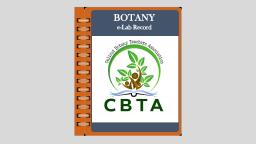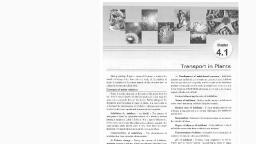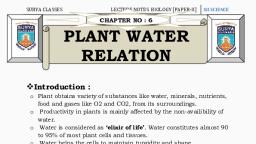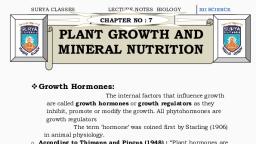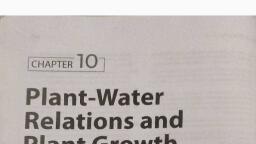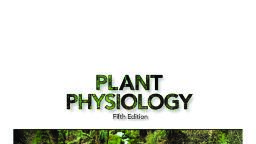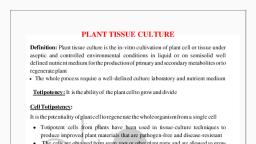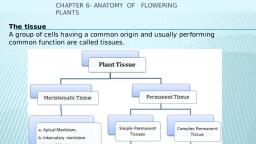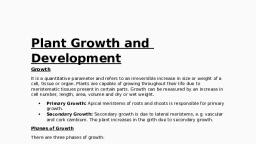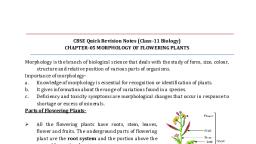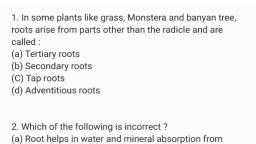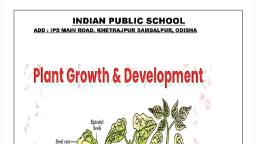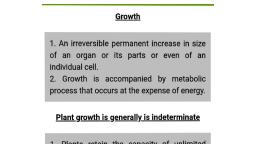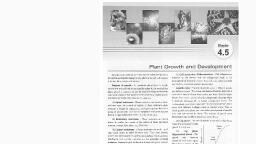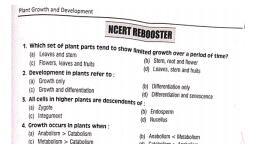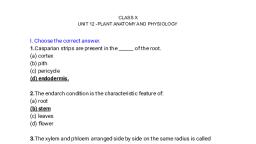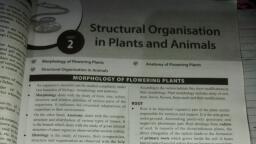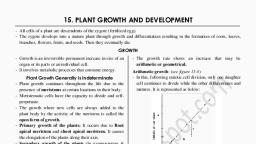Page 1 :
[cHapter 10], , Plant-Water, Relations and, Plant Growth, , In plants, transport may start from roots (underground, part) or from leaves (aerial part). The substances that, would need to be transported in plants are water,, mineral nutrients, organic nutrients, enzymes and growth, regulators. The specialised tissues involved in the, transportation of water and organic solutes are xylem, and phloem, respectively., The transportation of substances in plants is a complex, multistep process that involves certain mechanisms and, processes such as transpiration, guttation,, , physiological, etc, All these processes are controlled by the availability, , of water., , Properties of Water, , Water is considered as ‘elixir of life’, It constitutes almost, 90 to 95% of most plant cells and tissues. Water helps, , the cells to maintain turgidity and shape., It shows following properties due to which it has great, , biological importance., » Water is in liquid form at room temperature and acts, , as universal solvent., Water is inert inorganic compound with neutral pH, when in pure form., , Water act as a transporting medium for dissolved, minerals and food molecules., , Water acts as a best aqueous medium for all, biochemical reactions taking place in a cell., , Water ig an essential raw material for photosynthes, Water has high specific heat, high heat of vaporisatios, and high heat of fusion. Due to this, it acts a thermal, buffer,, , Water molecules also have good adhesive and, cohesive forces of attraction. This help in capillary, movement of water inside the plant., , ‘Therefore water, act as a significant molecule that, connects physical world with biological processes., , Water Absorbing Organs of, the Plants, ns of the plants, , Roots are the main water absorbing orga’, and floating hydrophytes. Certain epiphytic plants absor?, water from atmosphere by their hygroscopic hanging, roots containing a special tissue called velamen, The root is divided in five distinct regions are 4% follows, , 2, , ., , * Root cap, * Meristematic zone, , « Zone of cell elongation, * Root hair zone, , + Zone of maturation
Page 2 :
water Relations and Plant Growth, it, , roots, the zone of maximum, , absorption j, atte e, In this zone, epidermal c huon is root, , ells are Present, , ay 201! : a, pe ma cells), which form unicellular hair-like, ons called root hairs, , pl, , exten", , , , The region of the root tip, , Structure of Root Hair, , Root hairs are actually cytoplasmic extension or, prolongation of epiblema cell, which are approx 1 mm to, 10mm long and are tube-like., , These are colourless, unbranched, short-lived, , (ephemeral) and very delicate. Each root hair has a large, central vacuole surrounded by thin film of cytoplasm,, plasma membrane and thin double layered cell wall., , The outer layer is composed of pectin and inner layer is, ofcellulose. Its cell wall is freely permeable, but plasma, membrane is selectively permeable., , Water Available to Roots, for Absorption, , Water is absorbed from the microenvironment, Surounding the root known as rhizosphere. Water, Present in soil is of following types, , (i) Gravitational water It is the water, which reaches, at the soil water table due to gravitational force,, after the rain fall. This form is not available to, plants, but available by mechanical methods or by, , _ tube well irrigation., , ti) Hygroseopic water Thin film of water is tightly held, by the soil particles is called hygroscopic water., , |. This water is also not available to the plants., , '\) Combined water The amount of water present in, the chemical compounds like hydrated oxides of, Silicon, aluminium, etc., which are present in the, — of soil, This is also not available to the, , ants,, , , , 241, , (iv) Capillary water Water exists between soil particles ¥, , small capillary pores is called capillary water. It is the, most common available form of water for absorption., Every living organism shows growth, which can either, be in size or in number. Hence, we can say that the, growth is a characteristic feature of all living forms of, life., There are various types of tissues. present ina plant, which occupy specific locations throughout their body., ‘These tissues have different structural and functional, aspects like growth and development. Growth in general, is considered as an increase in size of the object., , Plant Growth Regulators, , Growth and development in plants are regulated by some, special chemical substances. These substances are also, called plant hormones or phytohormones as termed by, Thimann in 1948., A plant hormone is an organic compound. It is synthesised, in one part of a plant in minute quantities and from there, it is translocated to another part where it causes a, physiological response., Some characteristics of plant growth regulators are, * These are essential organic compounds required in very, small quantities., * These are generally synthesised at the apices of root,, stem and in leaves., + A single hormone may regulate different aspects of, growth., , + Their synthesis is under genetic control and influenced, by environmental factors also., , Types of Plant Growth Regulators, They can be placed under two groups based on their functions, (i) Growth promoters, e.g. auxin, gibberellin and cytokinin., , (ii) Growth inhibitors, e.g. abscisic acid and ethylene can, induce, dormancy and abseission,, , Auxin, , Auxins are weak organic acid produced naturally by, plants. It was the first plant growth regulator to be, discovered. Chemically, auxins are indole derivates., , They are organic acids. Auxins are synthesised from their, precursor tryptophan (amino acid). They are translocated, in polar manner. In plants, the first auxin was isolated, from coleoptile tips of oat (Avena sativa) seedlings in the, form of Indole-3-Acetic Acid (IAA) by FW Went (1928)., , Note Bioassay is a analytical method to determine the, , concentration of substance by its effect on living cell or, tissues.
